 |
| FIG. 920– Right osseous labyrinth. Lateral view. |
|
(Auris Interna) The internal ear is the essential part of the organ of hearing, receiving the ultimate distribution of the auditory nerve. It is called the labyrinth, from the complexity of its shape, and consists of two parts: the osseous labyrinth, a series of cavities within the petrous part of the temporal bone, and the membranous labyrinth, a series of communicating membranous sacs and ducts, contained within the bony cavities. |
| |
| The Osseous Labyrinth (labyrinthus osseus) (Figs. 920, 921).—The osseous labyrinth consists of three parts: the vestibule, semicircular canals, and cochlea. These are cavities hollowed out of the substance of the bone, and lined by periosteum; they contain a clear fluid, the perilymph, in which the membranous labyrinth is situated. |
| |
| The Vestibule (vestibulum).—The vestibule is the central part of the osseous labyrinth, and is situated medial to the tympanic cavity, behind the cochlea, and in front of the semicircular canals. It is somewhat ovoid in shape, but flattened transversely; it measures about 5 mm. from before backward, the same from above downward, and about 3 mm. across. In its lateral or tympanic wall is the fenestra vestibuli, closed, in the fresh state, by the base of the stapes and annular ligament. On its medial wall, at the forepart, is a small circular depression, the recessus sphæricus, which is perforated, at its anterior and inferior part, by several minute holes (macula cribrosa media) for the passage of filaments of the acoustic nerve to the saccule; and behind this depression is an oblique ridge, the crista vestibuli, the anterior end of which is named the pyramid of the vestibule. This ridge bifurcates below to enclose a small depression, the fossa cochlearis, which is perforated by a number of holes for the passage of filaments of the acoustic nerve which supply the vestibular end of the ductus cochlearis. As the hinder part of the medial wall is the orifice of the aquæductus vestibuli, which extends to the posterior surface of the petrous portion of the temporal bone. It transmits a small vein, and contains a tubular prolongation of the membranous labyrinth, the ductus endolymphaticus, which ends in a cul-de-sac between the layers of the dura mater within the cranial cavity. On the upper wall or roof is a transversely oval depression, the recessus ellipticus, separated from the recessus sphæricus by the crista vestibuli already mentioned. The pyramid and adjoining part of the recessus ellipticus are perforated by a number of holes (macula cribrosa superior). The apertures in the pyramid transmit the nerves to the utricle; those in the recessus ellipticus the nerves to the ampullæ of the superior and lateral semicircular ducts. Behind are the five orifices of the semicircular canals. In front is an elliptical opening, which communicates with the scala vestibuli of the cochlea. |
| |
 |
| FIG. 921– Interior of right osseous labyrinth. |
| |
| |
| The Bony Semicircular Canals (canales semicirculares ossei).—The bony semicircular canals are three in number, superior, posterior, and lateral, and are situated above and behind the vestibule. They are unequal in length, compressed from side to side, and each describes the greater part of a circle. Each measures about 0.8 mm. in diameter, and presents a dilatation at one end, called the ampulla, which measures more than twice the diameter of the tube. They open into the vestibule by five orifices, one of the apertures being common to two of the canals. |
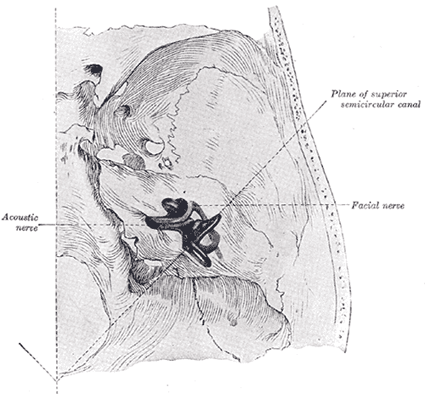 |
| FIG. 922– Position of the right bony labyrinth of the ear in the skull, viewed from above. The temporal bone is considered transparent and the labyrinth drawn in from a corrosion preparation. (Spalteholz.) |
| |
| The superior semicircular canal (canalis semicircularis superior), 15 to 20 mm. in length, is vertical in direction, and is placed transversely to the long axis of the petrous portion of the temporal bone, on the anterior surface of which its arch forms a round projection. It describes about two-thirds of a circle. Its lateral extremity is ampullated, and opens into the upper part of the vestibule; the opposite end joins with the upper part of the posterior canal to form the crus commune, which opens into the upper and medial part of the vestibule. |
| The posterior semicircular canal (canalis semicircularis posterior), also vertical, is directed backward, nearly parallel to the posterior surface of the petrous bone; it is the longest of the three, measuring from 18 to 22 mm.; its lower or ampullated end opens into the lower and back part of the vestibule, its upper into the crus commune already mentioned. |
| The lateral or horizontal canal (canalis semicircularis lateralis; external semicircular canal) is the shortest of the three. It measures from 12 to 15 mm., and its arch is directed horizontally backward and lateralward; thus each semicircular canal stands at right angles to the other two. Its ampullated end corresponds to the upper and lateral angle of the vestibule, just above the fenestra vestibuli, where it opens close to the ampullated end of the superior canal; its opposite end opens at the upper and back part of the vestibule. The lateral canal of one ear is very nearly in the same plane as that of the other; while the superior canal of one ear is nearly parallel to the posterior canal of the other. |
 |
| FIG. 923– The cochlea and vestibule, viewed from above. All the hard parts which form the roof of the internal ear have been removed with the saw. |
| |
| The Cochlea (Figs. 922, 923).—The cochlea bears some resemblance to a common snail-shell; it forms the anterior part of the labyrinth, is conical in form, and placed almost horizontally in front of the vestibule; its apex (cupula) is directed forward and lateralward, with a slight inclination downward, toward the upper and front part of the labyrinthic wall of the tympanic cavity; its base corresponds with the bottom of the internal acoustic meatus, and is perforated by numerous apertures for the passage of the cochlear division of the acoustic nerve. It measures about 5 mm. from base to apex, and its breadth across the base is about 9 mm. It consists of a conical shaped central axis, the modiolus; of a canal, the inner wall of which is formed by the central axis, wound spirally around it for two turns and three-quarters, from the base to the apex; and of a delicate lamina, the osseous spiral lamina, which projects from the modiolus, and, following the windings of the canal, partially subdivides it into two. In the recent state a membrane, the basilar membrane, stretches from the free border of this lamina to the outer wall of the bony cochlea and completely separates the canal into two passages, which, however, communicate with each other at the apex of the modiolus by a small opening named the helicotrema. |
| The modiolus is the conical central axis or pillar of the cochlea. Its base is broad, and appears at the bottom of the internal acoustic meatus, where it corresponds with the area cochleæ; it is perforated by numerous orifices, which transmit filaments of the cochlear division of the acoustic nerve; the nerves for the first turn and a half pass through the foramina of the tractus spiralis foraminosus; those for the apical turn, through the foramen centrale. The canals of the tractus spiralis foraminosus pass up through the modiolus and successively bend outward to reach the attached margin of the lamina spiralis ossea. Here they become enlarged, and by their apposition form the spiral canal of the modiolus, which follows the course of the attached margin of the osseous spiral lamina and lodges the spiral ganglion (ganglion of Corti). The foramen centrale is continued into a canal which runs up the middle of the modiolus to its apex. The modiolus diminishes rapidly in size in the second and succeeding coil. |
| The bony canal of the cochlea takes two turns and three-quarters around the modiolus. It is about 30 mm. in length, and diminishes gradually in diameter from the base to the summit, where it terminates in the cupula, which forms the apex of the cochlea. The beginning of this canal is about 3 mm. in diameter; it diverges from the modiolus toward the tympanic cavity and vestibule, and presents three openings. One, the fenestra cochleæ, communicates with the tympanic cavity—in the fresh state this aperture is closed by the secondary tympanic membrane; another, of an elliptical form, opens into the vestibule. The third is the aperture of the aquæductus cochleæ, leading to a minute funnel-shaped canal, which opens on the inferior surface of the petrous part of the temporal bone and transmits a small vein, and also forms a communication between the subarachnoid cavity and the scala tympani. |
| The osseous spiral lamina (lamina spiralis ossea) is a bony shelf or ledge which projects from the modiolus into the interior of the canal, and, like the canal, takes two-and three-quarter turns around the modiolus. It reaches about half-way toward the outer wall of the tube, and partially divides its cavity into two passages or scalæ, of which the upper is named the scala vestibuli, while the lower is termed the scala tympani. Near the summit of the cochlea the lamina ends in a hook-shaped process, the hamulus laminæ spiralis; this assists in forming the boundary of a small opening, the helicotrema, through which the two scalæ communicate with each other. From the spiral canal of the modiolus numerous canals pass outward through the osseous spiral lamina as far as its free edge. In the lower part of the first turn a second bony lamina, the secondary spiral lamina, projects inward from the outer wall of the bony tube; it does not, however, reach the primary osseous spiral lamina, so that if viewed from the vestibule a narrow fissure, the vestibule fissure, is seen between them. |
| The osseous labyrinth is lined by an exceedingly thin fibro-serous membrane; its attached surface is rough and fibrous, and closely adherent to the bone; its free surface is smooth and pale, covered with a layer of epithelium, and secretes a thin, limpid fluid, the perilymph. A delicate tubular process of this membrane is prolonged along the aqueduct of the cochlea to the inner surface of the dura mater. |
| |
| The Membranous Labyrinth (labyrinthus membranaceus) (Figs. 924, 925, 926).—The membranous labyrinth is lodged within the bony cavities just described, and has the same general form as these; it is, however, considerably smaller, and is partly separated from the bony walls by a quantity of fluid, the perilymph. In certain places it is fixed to the walls of the cavity. The membranous labyrinth contains fluid, the endolymph, and on its walls the ramifications of the acoustic nerve are distributed. |
| Within the osseous vestibule the membranous labyrinth does not quite preserve the form of the bony cavity, but consists of two membranous sacs, the utricle, and the saccule. |
| |
| The Utricle (utriculus).—The utricle, the larger of the two, is of an oblong form, compressed transversely, and occupies the upper and back part of the vestibule, lying in contact with the recessus ellipticus and the part below it. That portion which is lodged in the recess forms a sort of pouch or cul-de-sac, the floor and anterior wall of which are thickened, and form the macula acustica utriculi, which receives the utricular filaments of the acoustic nerve. The cavity of the utricle communicates behind with the semicircular ducts by five orifices. From its anterior wall is given off the ductus utriculosaccularis, which opens into the ductus endolymphaticus. |
| |
| The Saccule (sacculus).—The saccule is the smaller of the two vestibular sacs; it is globular in form, and lies in the recessus sphæricus near the opening of the scala vestibuli of the cochlea. Its anterior part exhibits an oval thickening, the macula acustica sacculi, to which are distributed the saccular filaments of the acoustic nerve. Its cavity does not directly communicate with that of the utricle. From the posterior wall a canal, the ductus endolymphaticus, is given off; this duct is joined by the ductus utriculosaccularis, and then passes along the aquæductus vestibuli and ends in a blind pouch (saccus endolymphaticus) on the posterior surface of the petrous portion of the temporal bone, where it is in contact with the dura mater. From the lower part of the saccule a short tube, the canalis reuniens of Hensen, passes downward and opens into the ductus cochlearis near its vestibular extremity (Fig. 924). |
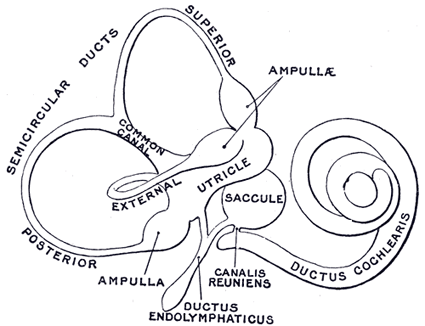 |
| FIG. 924– The membranous labyrinth. (Enlarged.) |
| |
| |
| The Semicircular Ducts (ductus semicirculares; membranous semicircular canals), (Figs. 925, 926).—The semicircular ducts are about one-fourth of the diameter of the osseous canals, but in number, shape, and general form they are precisely similar, and each presents at one end an ampulla. They open by five orifices into the utricle, one opening being common to the medial end of the superior and the upper end of the posterior duct. In the ampullæ the wall is thickened, and projects into the cavity as a fiddle-shaped, transversely placed elevation, the septum transversum, in which the nerves end. |
| The utricle, saccule, and semicircular ducts are held in position by numerous fibrous bands which stretch across the space between them and the bony walls. |
| |
| Structure (Fig. 927).—The walls of the utricle, saccule, and semicircular ducts consist of three layers. The outer layer is a loose and flocculent structure, apparently composed of ordinary fibrous tissue containing bloodvessels and some pigment-cells. The middle layer, thicker and more transparent, forms a homogeneous membrana propria, and presents on its internal surface, especially in the semicircular ducts, numerous papilliform projections, which, on the addition of acetic acid, exhibit an appearance of longitudinal fibrillation. The inner layer is formed of polygonal nucleated epithelial cells. In the maculæ of the utricle and saccule, and in the transverse septa of the ampullæ of the semicircular ducts, the middle coat is thickened and the epithelium is columnar, and consists of supporting cells and hair cells. The former are fusiform, and their deep ends are attached to the membrana propria, while their free extremities are united to form a thin cuticle. The hair cells are flask-shaped, and their deep, rounded ends do not reach the membrana propria, but lie between the supporting cells. The deep part of each contains a large nucleus, while its more superficial part is granular and pigmented. The free end is surmounted by a long, tapering, hair-like filament, which projects into the cavity. The filaments of the acoustic nerve enter these parts, and having pierced the outer and middle layers, they lose their medullary sheaths, and their axis-cylinders ramify between the hair cells. |
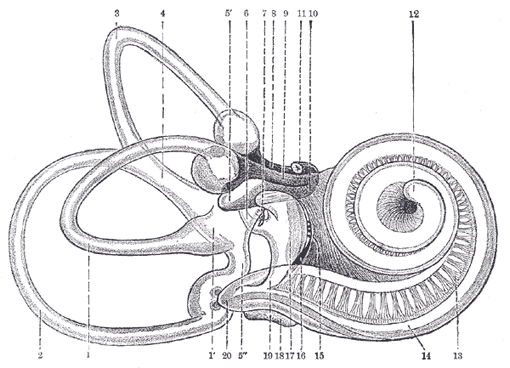 |
| FIG. 925– Right human membranous labyrinth, removed from its bony enclosure and viewed from the antero-lateral aspect. (G. Retzius.) |
| |
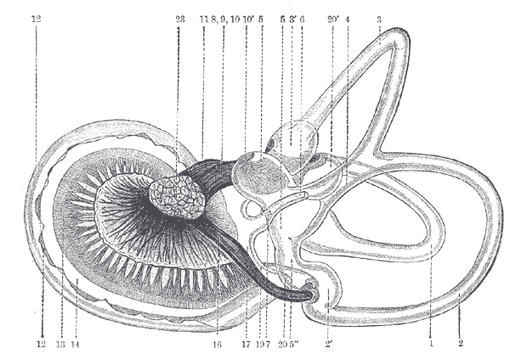 |
| FIG. 926– The same from the postero-medial aspect. 1. Lateral semicircular canal; 1’, its ampulla; 2. Posterior canal; 2’, its ampulla. 3. Superior canal; 3’, its ampulla. 4. Conjoined limb of superior and posterior canals (sinus utriculi superior). 5. Utricle. 5’. Recessus utriculi. 5”. Sinus utriculi posterior. 6. Ductus endolymphaticus. 7. Canalis utriculosaccularis. 8. Nerve to ampulla of superior canal. 9. Nerve to ampulla of lateral canal. 10. Nerve to recessus utriculi (in Fig. 925, the three branches appear conjoined). 10’. Ending of nerve in recessus utriculi. 11. Facial nerve. 12. Lagena cochleæ. 13. Nerve of cochlea within spiral lamina. 14. Basilar membrane. 15. Nerve fibers to macula of saccule. 16. Nerve to ampulla of posterior canal. 17. Saccule. 18. Secondary membrane of tympanum. 19. Canalis reuniens. 20. Vestibular end of ductus cochlearis. 23. Section of the facial and acoustic nerves within internal acoustic meatus (the separation between them is not apparent in the section). (G. Retzius.) |
| |
| Two small rounded bodies termed otoconia, each consisting of a mass of minute crystalline grains of carbonate of lime, held together in a mesh of gelatinous tissue, are suspended in the endolymph in contact wish the free ends of the hairs projecting from the maculæ. According to Bowman, a calcareoutmaterial is also sparingly scattered in the cells lining the ampullæ of the semicircular ducts. |
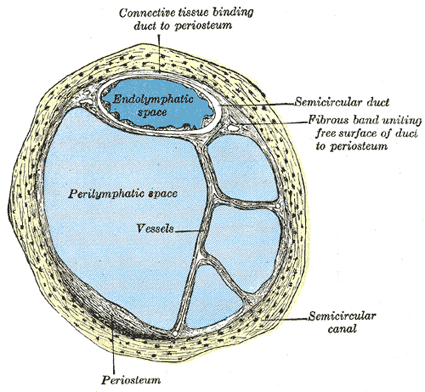 |
| FIG. 927– Transverse section of a human semicircular canal and duct (after Rüdinger). |
| |
| |
| The Ductus Cochlearis (membranous cochlea; scala media).—The ductus cochlearis consists of a spirally arranged tube enclosed in the bony canal of the cochlea and lying along its outer wall. |
| As already stated, the osseous spiral lamina extends only part of the distance between the modiolus and the outer wall of the cochlea, while the basilar membrane stretches from its free edge to the outer wall of the cochlea, and completes the roof of the scala tympani. A second and more delicate membrane, the vestibular membrane (Reissneri) extends from the thickened periosteum covering the osseous spiral lamina to the outer wall of the cochlea, where it is attached at some little distance above the outer edge of the basilar membrane. A canal is thus shut off between the scala tympani below and the scala vestibuli above; this is the ductus cochlearis or scala media (Fig. 928). It is triangular on transverse section, its roof being formed by the vestibular membrane, its outer wall by the periosteum lining the bony canal, and its floor by the membrana basilaris and the outer part of the lamina spiralis ossea. Its extremities are closed; the upper is termed the lagena and is attached to the cupula at the upper part of the helicotrema; the lower is lodged in the recessus cochlearis of the vestibule. Near the lower end the ductus cochlearis is brought into continuity with the saccule by a narrow, short canal, the canalis reuniens of Hensen (Fig. 924). On the membrana basilaris is situated the spiral organ of Corti. The vestibular membrane is thin and homogeneous, and is covered on its upper and under surfaces by a layer of epithelium. The periosteum, forming the outer wall of the ductus cochlearis, is greatly thickened and altered in character, and is called the spiral ligament. It projects inward below as a triangular prominence, the basilar crest, which gives attachment to the outer edge of the basilar membrane; immediately above the crest is a concavity, the sulcus spiralis externus. The upper portion of the spiral ligament contains numerous capillary loops and small bloodvessels, and is termed the stria vascularis. |
| The osseous spiral lamina consists of two plates of bone, and between these are the canals for the transmission of the filaments of the acoustic nerve. On the upper plate of that part of the lamina which is outside the vestibular membrane, the periosteum is thickened to form the limbus laminæ spiralis (Fig. 929), this ends externally in a concavity, the sulcus spiralis internus, which represents, on section, the form of the letter C; the upper part, formed by the overhanging extremity of the limbus, is named the vestibular lip; the lower part, prolonged and tapering, is called the tympanic lip, and is perforated by numerous foramina for the passage of the cochlear nerves. The upper surface of the vestibular lip is intersected at right angles by a number of furrows, between which are numerous elevations; these present the appearance of teeth along the free surface and margin of the lip, and have been named by Huschke the auditory teeth (Fig. 930). The limbus is covered by a layer of what appears to be squamous epithelium, but the deeper parts of the cells with their contained nuclei occupy the intervals between the elevations and between the auditory teeth. This layer of epithelium is continuous on the one hand with that lining the sulcus spiralis internus, and on the other with that covering the under surface of the vestibular membrane. |
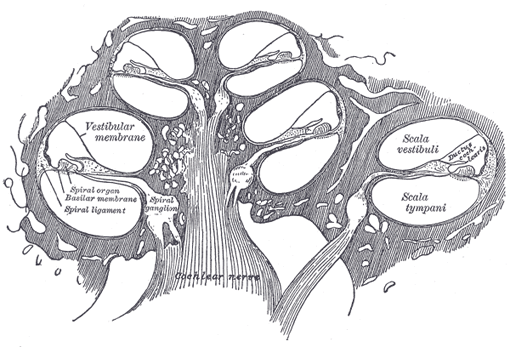 |
| FIG. 928– Diagrammatic longitudinal section of the cochlea. |
| |
 |
| FIG. 929– Floor of ductus cochlearis. |
| |
| |
| Basilar Membrane.—The basilar membrane stretches from the tympanic lip of the osseous spiral lamina to the basilar crest and consists of two parts, an inner and an outer. The inner is thin, and is named the zona arcuata: it supports the spiral organ of Corti. The outer is thicker and striated, and is termed the zona pectinata. The under surface of the membrane is covered by a layer of vascular connective tissue; one of the vessels in this tissue is somewhat larger than the rest, and is named the vas spirale; it lies below Corti’s tunnel. |
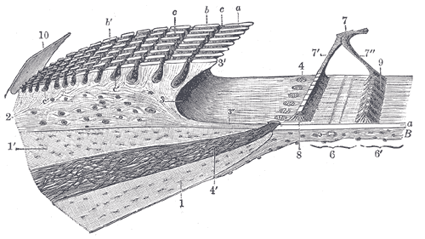 |
| FIG. 930– Limbus laminæ spiralis and membrana basilaris. (Schematic.) 1, 1’. Upper and lower lamellæ of the lamina spiralis ossea. 2. Limbus laminæ spiralis, with a, the teeth of the first row; b, b’, the auditory teeth of the other rows; c, c’, the interdental grooves and the cells which are lodged in them. 3. Sulcus spiralis internus, with 3’, its labium vestibulare, and 3”, its labium tympanicum. 4. Foramina nervosa, giving passage to the nerves from the ganglion spirale or ganglion of Corti. 5. Vas spirale. 6. Zona arcuata, and 6’, zona pectinata of the basilar membrane, with a, its hyaline layer, B, its connective-tissue layer. 7. Arch of spiral organ, with 7’, its inner rod, and 7”, its outer rod. 8. Feet of the internal rods, from which the cells are removed. 9. Feet of the external rods. 10. Vestibular membrane, at its origin. (Testut.) |
| |
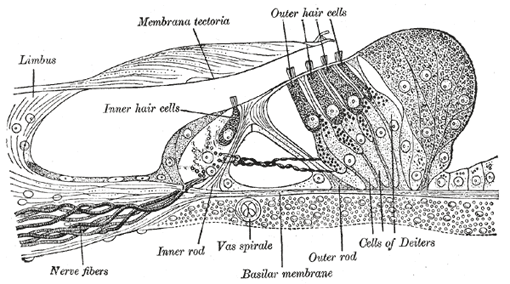 |
| FIG. 931– Section through the spiral organ of Corti. Magnified. (G. Retzius.) |
| |
| The spiral organ of Corti (organon spirale [Corti]; organ of Corti) (Figs. 931, 932) is composed of a series of epithelial structures placed upon the inner part of the basilar membrane. The more central of these structures are two rows of rod-like bodies, the inner and outer rods or pillars of Corti. The bases of the rods are supported on the basilar membrane, those of the inner row at some distance from those of the outer; the two rows incline toward each other and, coming into contact above, enclose between them and the basilar membrane a triangular tunnel, the tunnel of Corti. On the inner side of the inner rods is a single row of hair cells, and on the outer side of the outer rods three or four rows of similar cells, together with certain supporting cells termed the cells of Deiters and Hensen. The free ends of the outer hair cells occupy a series of apertures in a net-like membrane, the reticular membrane, and the entire organ is covered by the tectorial membrane. |
| RODS OF CORTI.—Each of these consists of a base or foot-plate, and elongated part or body, and an upper end or head; the body of each rod is finely striated, but in the head there is an oval non-striated portion which stains deeply with carmine. Occupying the angles between the rods and the basilar membrane are nucleated cells which partly envelop the rods and extend on to the floor of Corti’s tunnel; these may be looked upon as the undifferentiated parts of the cells from which the rods have been formed. |
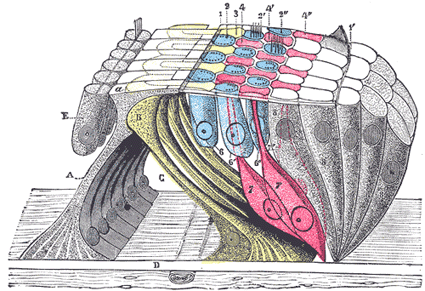 |
| FIG. 932– The lamina reticularis and subjacent structures. (Schematic.) A. Internal rod of Corti, with a, its plate. B. External rod (in yellow). C. Tunnel of Corti. D. Membrana basilaris. E. Inner hair cells. 1, 1’. Internal and external borders of the membrana reticularis. 2, 2’, 2”. The three rows of circular holes (in blue). 3. First row of phalanges (in yellow). 4, 4’, 4”. Second, third, and fourth rows of phalanges (in red). 6, 6’, 6”. The three rows of outer hair cells (in blue). 7, 7’, 7”. Cells of Deiters. 8. Cells of Hensen and Claudius. (Testut.) |
| |
| The inner rods number nearly 6000, and their bases rest on the basilar membrane close to the tympanic lip of the sulcus spiralis internus. The shaft or body of each is sinously curved and forms an angle of about 60 degrees with the basilar membrane. The head resembles the proximal end of the ulna and presents a deep concavity which accommodates a convexity on the head of the outer rod. The head-plate, or portion overhanging the concavity, overlaps the head-plate of the outer rod. |
| The outer rods, nearly 4000 in number, are longer and more obliquely set than the inner, forming with the basilar membrane an angle of about 40 degrees. Their heads are convex internally; they fit into the concavities on the heads of the inner rods and are continued outward as thin flattened plates, termed phalangeal processes, which unite with the phalangeal processes of Deiters’ cells to form the reticular membrane. |
| |
| Hair Cells.—The hair cells are short columnar cells; their free ends are on a level with the heads of Corti’s rods, and each is surmounted by about twenty hair-like processes arranged in the form of a crescent with its concavity directed inward. The deep ends of the cells reach about half-way along Corti’s rods, and each contains a large nucleus; in contact with the deep ends of the hair cells are the terminal filaments of the cochlear division of the acoustic nerve. The inner hair cells are arranged in a single row on the medial side of the inner rods, and their diameters being greater than those of the rods it follows that each hair cell is supported by more than one rod. The free ends of the inner hair cells are encircled by a cuticular membrane which is fixed to the heads of the inner rods. Adjoining the inner hair cells are one or two rows of columnar supporting cells, which, in turn, are continuous with the cubical cells lining the sulcus spiralis internus. The outer hair cells number about 12,000, and are nearly twice as long as the inner. In the basal coil of the cochlea they are arranged in three regular rows; in the apical coil, in four, somewhat irregular, rows. |
| Between the rows of the outer hair cells are rows of supporting cells, called the cells of Deiters; their expanded bases are planted on the basilar membrane, while the opposite end of each presents a clubbed extremity or phalangeal process. Immediately to the outer side of Deiters’ cells are five or six rows of columnar cells, the supporting cells of Hensen. Their bases are narrow, while their upper parts are expanded and form a rounded elevation on the floor of the ductus cochlearis. The columnar cells lying outside Hensen’s cells are termed the cells of Claudius. A space exists between the outer rods of Corti and the adjacent hair cells; this is called the space of Nuel. |
| The reticular lamina (Fig. 932) is a delicate frame-work perforated by rounded holes which are occupied by the free ends of the outer hair cells. It extends from the heads of the outer rods of Corti to the external row of the outer hair cells, and is formed by several rows of “minute fiddle-shaped cuticular structures,” called phalanges, between which are circular apertures containing the free ends of the hair cells. The inner most row of phalanges consists of the phalangeal processes of the outer rods of Corti; the outer rows are formed by the modified free ends of Deiters’ cells. |
| Covering the sulcus spiralis internus and the spiral organ of Corti is the tectorial membrane, which is attached to the limbus laminæ spiralis close to the inner edge of the vestibular membrane. Its inner part is thin and overlies the auditory teeth of Huschke; its outer part is thick, and along its lower surface, opposite the inner hair cells, is a clear band, named Hensen’s stripe, due to the intercrossing of its fibers. The lateral margin of the membrane is much thinner. Hardesty (*151 considers the tectorial membrane as the vibrating mechanism in the cochlea. It is inconceivably delicate and flexible; far more sensitively flexible in the transverse than in the longitudinal direction and the readiness with which it bends when touched is beyond description. It is ectodermal in origin. It consists of fine colorless fibers embedded in a transparent matrix (the matrix may be a variety of soft keratin), of a soft collagenous, semisolid character with marked adhesiveness. The general transverse direction of the fibers inclines from the radius of the cochlea toward the apex. |
| The acoustic nerve (n. acusticus; auditory nerve or nerve of hearing) divides near the bottom of the internal acoustic meatus into an anterior or cochlear and a posterior or vestibular branch. |
| The vestibular nerve (n. vestibularis) supplies the utricle, the saccule, and the ampullæ of the semicircular ducts. On the trunk of the nerve, within the internal acoustic meatus, is a ganglion, the vestibular ganglion (ganglion of Scarpa); the fibers of the nerve arise from the cells of this ganglion. On the distal side of the ganglion the nerve splits into a superior, an inferior, and a posterior branch. (*152 The filaments of the superior branch are transmitted through the foramina in the area vestibularis superior, and end in the macula of the utricle and in the ampullæ of the superior and lateral semicircular ducts; those of the inferior branch traverse the foramina in the area vestibularis inferior, and end in the macula of the saccule. The posterior branch runs through the foramen singulare at the postero-inferior part of the bottom of the meatus and divides into filaments for the supply of the ampulla of the posterior semicircular duct. |
| The cochlear nerve (n. cochlearis) divides into numerous filaments at the base of the modiolus; those for the basal and middle coils pass through the foramina in the tractus spiralis foraminosis, those for the apical coil through the canalis centralis, and the nerves bend outward to pass between the lamellæ of the osseous spiral lamina. Occupying the spiral canal of the modiolus is the spiral ganglion of the cochlea (ganglion of Corti) (Fig. 933), consisting of bipolar nerve cells, which constitute the cells of origin of this nerve. Reaching the outer edge of the osseous spiral lamina, the fibers of the nerve pass through the foramina in the tympanic lip; some end by arborizing around the bases of the inner hair cells, while others pass between Corti’s rods and across the tunnel, to end in a similar manner in relation to the outer hair cells. The cochlear nerve gives off a vestibular branch to supply the vestibular end of the ductus cochlearis; the filaments of this branch pass through the foramina in the fossa cochlearis (page 1048). |
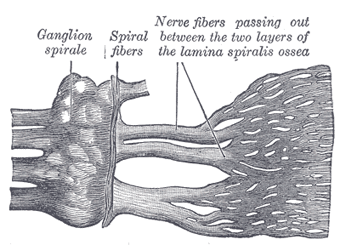 |
| FIG. 933– Part of the cochlear division of the acoustic nerve, highly magnified. (Henle.) |
| |
| |
| Vessels.—The arteries of the labyrinth are the internal auditory, from the basilar, and the stylomastoid, from the posterior auricular. The internal auditory artery divides at the bottom of the internal acoustic meatus into two branches: cochlear and vestibular. The cochlear branch subdivides into twelve or fourteen twigs, which traverse the canals in the modiolus, and are distributed, in the form of a capillary net-work, in the lamina spiralis and basilar membrane. The vestibular branches are distributed to the utricle, saccule, and semicircular ducts. |
| The veins of the vestibule and semicircular canals accompany the arteries, and, receiving those of the cochlea at the base of the modiolus, unite to form the internal auditory veins which end in the posterior part of the superior petrosal sinus or in the transverse sinus. |














